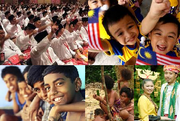
| |||||||||||||||
|
Top-left: Malay Muslims praying | |||||||||||||||
| Regions with significant populations | |||||||||||||||
|---|---|---|---|---|---|---|---|---|---|---|---|---|---|---|---|
| |||||||||||||||
| Languages | |||||||||||||||
|
Bahasa Malaysia/Melayu (Malay) | |||||||||||||||
| Religion | |||||||||||||||
|
Mostly Islam (60%) | |||||||||||||||
| Related ethnic groups | |||||||||||||||
|
Other Austronesians (Filipinos, Javanese people), Indians, Han Chinese |
The Malaysian people are the citizens, inhabitants and anyone associated with the country of Southeast Asian country of Malaysia. Malaysia is a multi-ethnic nation, although it is a Malay state that professes Islam as its state religion; Malaysia is home to Malays, Chinese, Indians and indigenous peoples known as the Orang Laut and Orang Asli. Other indigenous groups include the Kadazan-Dusun, Dayaks, Iban, Malaysian Siamese, Bajaus and Suluks. Due to Malaysia's close and important history with Indonesia, an overwhelming handful of Malaysians contain descent from the ethnic groups of Indonesia, particularly Javanese and Buginese, also Austronesian ethnic groups. The natives within the country now known as Malaysia are known as the Bumiputra.
Etymology[]
The term Malaysia originated from the term Malay, the term for the Austronesian ethnic group that is native to Maritime Southeast Asia which in the Malay language known as Melayu. Malaysia was once the British territory of Malaya, which spanned the Malay Peninsula, today West Malaysia. The native groups of Malaysia are known as the Bumiputra, including non-Ausrronesians such as the Thai Malaysians (or Malaysian Siamese) - native Thai-speakers and their generations who are born within the territory now known as Malaysia.
An alternate yet unknown root of the name Malaysia originates in its Hindu Buddhist heritage. The term Malay though referring to the ethnic group that is native to Maritime Southeast Asia, is also a Tamil word 'Malai" meaning mountain. Being a mountainous region, the natives used to call it "Malai ooru", literally Mountainous country. This term was then appropriated to denote the local natives of this mountainous land.
History[]
Early History & Ancestry[]
Malaysian Malays and Orang Asli []
Malaysia is inhabited by Malays, who comprise about 50% of the popuatlion, with large Chinese, Indian and communities of Orang tribes. These groups have all contributed to the development of Malaysia today. The ethnic Malay, especially Malaysian Malays people have several various ancestral origins themselves, containing a hodgepodge of both Austro-Asiatic,
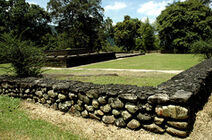
Ruins of an ancient kingdom in Malaysia's Bujang Valley in Kedah
Austronesian, Indian and Chinese origin. The Austronesian languages resulted from migrants from China, Madagascar and Taiwan. Malays are descended from two prehistoric migrations, a maritime migration of Austronesian people from Taiwan, China and Philippines; and a land migration from China to the Malay Peninsula, into Thailand, Singapore and Peninsular Malaysia and into Sumatra of Austro-Asiatic tribes. The Orang Asli tribes share an identical ancestrial history as the Malays, they are Austronesian tribes in Malaysia. The other Autronesian tribes, the Bumiputra of Malaysia, such as the Ibans, Tausūgs (known as Suluks in Malaysia, they are also native to the southern Philippines many of the existing communities in Malaysia are Filipino migrants) and Bajaus share this ancestry as well. The expatriat Filipino communities of Malaysia also share this ancestry.
Malaysian Indians[]
Indians are predominant in Malaysia's history, as well as other parts of the Malay Archipelago. Traders, merchants and missionaries from the Indian Subcontinent introduced the Indo-Aryan languages, such as Sanskrit and Pali and brought Hinduism to the islands under the reign of the Chola Dynasty and exerted their influence there thoroughly. Indian migration continued to the islands when Indian Muslims introduced Islam to Malaysia, and persisted through British colonialism when sepoys and natives from the Indian Subcontinent were brought to Malaysia as workers. Sambanthan Thevar, a Malaysian Indian and one of the country's founding fathers found the Malaysian Indian Congress, which looked out for the lives of Indians living in British Malaya, and later the state of Malaysia.
Malaysian Chinese[]
Like the Indians, the Chinese people have had a great historical presence in Malaysia. It is Chinese travellers like I-Tsing who discovered early Malay kingdoms in the continent. Waves of Chinese migrants arrived in Malacca during the fifteenth century, in the seventeenth century they inhabited Singapore but adhered to local customs and traditions. The third wave arrived during the Qing Dynasty of China.
Srivijaya Kingdom 600-1200[]
According to the Kedukan Bukit Inscription, in 682 A.D., a military leader by the name of Dapunta Hyang Sri Jayanasa came to Palembang from Tamwan and Jambi with 20,000 soldiers. In Pelambang, Sri Jayanasa
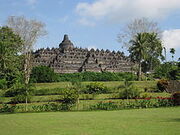
The Ancient Srivijayan Hindu temple in Borobudur, Indonesia
established a central capital that became the Srivijaya Empire (c. 600-1200 A.D.), which became one of the main region of power in the Malay Peninsula and Southeast Asia. I-Tsing arrived in Srivijaya in 688 A.D. and stayed there for seven years. He referred to the Srivijayan kingdom as Bogha which was a trader partner of China. The Arabs and Persians therefore also became aware of Srivijaya, and led to the latter Islamization of the Malay Archipelago. Armies from the nearby island of Java threatened the Malay communities in Sumatra. In 990, a Javanese kingdom known from central Java known as the Mataram
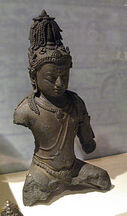
A 9th century statue of Maitreya from Sumatra in Indonesia
invaded Srivijaya but failed to conquer it which led to the establishment of a military protectorate with China at Chulamanivarmadeva's (ruler of Srivijaya) request. In 1006 A.D., the Srivijayans conquered Mataram. The Indians had not forgotten about the Malay Archipelago, prompting an invasion led by Rajendra Chola from the Coromandel Peninsula in India. Chola also failed to conquer Srivijaya. In 1025 however, he led a re-strengthened invasion that gave him new territory in Sumatra and the Malay Peninsula. All that remained was Palembang in Indonesia, with Javanese naval forces would siege. Palembang's kings turned to China again for military aid, but it was too late, the conquest of Palembang was complete and the Chinese officials that were sent there were killed by the new Javanese rulers.[5] Srivijayan politics reflected Indian influence. Rajahs and datus were Austronesian governers of lower-ranking nobility. They ruled states known as rajahnates smaller principalities known as barangays. Sri was also a title of supreme royalty, also of Indian influence. After Melayu and Srivijaya's defeat against Javanese armies, Malays came under Javanese rule in the Majapahit Empire until Islam's arrival which would form the backbone of the enmity between these two groups that perrsisted over the centuries.[6][7]
Melayu Kingdom 688-695 B.C.[]
The existance of the classical kingdom known as Malayu (Chinese: 末羅瑜國 Mòluóyú Guó) is rooted straight
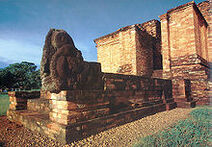
Candi Gumpung, a Buddhist temple at Muaro Jambi of Malayu Kingdom, later integrated as one of Srivijaya's important urban center.
from I-Tsing's accounts on this voyages to Southeast Asia. This kingdom had very close ties with Srivijaya, it is noted that it could have been a vessel kingdom to Srivijaya, or any nature that involved Srivijayan control.
This extract from I-Tsing accounts gives a brief description of his travel route between Bogha (Srivijaya) and the civilization known as the Malayu.
"Wu Hing came to Bogha after a month's sail. The king received him very favourably and respected him as a guest from the land of the son of heaven of the Great Tang. He went on board the king's ship to the country of Malayu and arrived there after fifteen days sail. Thence he went to Ka Cha, again after fifteen days. At the end of winter he changed ship and sailed to the west."
I-Tsing describes its location in this next excerpt,
"In the country of Sribogha, we see the shadow of the dial-plate become neither long nor short (i.e "remain unchanged" or "no shadow") in the middle of the eighth month (Autumnal equinox), and at midday no shadow falls from a man who is standing on that day, so it is in the middle of spring (Vernal equinox)."
The descriptions of the geographical instruments lead many historians to pin-point a kingdom spanning the earth's equator. The kingdom could have spanned northeastern Sumatra, Malacca and Pelambang. Buddhism was the predominant religion in this particular state, the Hinayana section. [8]
Islamization & Golden Age of Sultanates[]
Circa 674 A.D., Arab traders introduced Islam in Sumatra in Indonesia but in 1100 A.D., Indian Muslim converts arrived in Kedah and converted its population to Islam. Malay rulers who converted to Islam became sultans
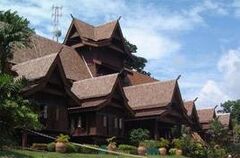
Replica of a Sultan's Palace in Malacca
. Phra Ong Mahawangsa, the Hindu king of Kedah, converted to Islam and changed his name to Muzaffar Shah, and became the first recorded sultan and convert in Malaysian history. The Kedah Sultanate therefore became Malaysia's first recorded-sultanate.[9] In 1405, Zheng He (1371-1433), a Chinese Muslim eunuch from the Ming Dynasty arrived in Java in Indonesia and Malacca on the way through his voyages in Southeast Asia. There, he became a main driving force in the mass conversion of the Southeast Asian natives to Islam.[10] He made more voyages in 1413, 1416 and 1433 and went back to Java and Malacca, converting more people to Islam.[11] During the 1416 and 1433 voyages, he reached Palembang in Malaysia and strengthened Islam in the region, characterizing and re-shaping the Malay culture of Malaysia. Many of the royal figures in the Malay regions adopted Islam and adhered to its traditions. The traditional rajahs or datus retained their ruling positions many converted to Islam and either became missionaries or subjects to sultans.
Sultanate of Malacca[]
In 1402, Parameswara, a Hindu prince from Singapore, converted to Islam and turned the ancient Srivijaya
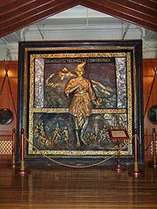
Hang Tuah
Kingdom into the Sultanate of Malacca (1402-1511). Parameswara changed his name to Iskander Shah (Jawi: إسكندر شه) as well. In 1444, Malacca became ruled by a Hindu king named Abu Syahid Shah. Unlike the other Malay rulers, Shah remained a Hindu and never converted to Islam; yet he was still titled as the Sultan of Malacca. Shah's rule as a non-Muslim sultan was very short-lived, he was murdered by Indian Muslims in 1446. Hang Tuah (Malay: هڠ تواه), a warrior from Malacca, is considered one of the most inspirational figures in Malay history renowned for his nationalistic battle cry, "Malays will never vanish off of the earth".[12]
Sultanate of Sulu and North Borneo[]
In 1380, an Arab trader named Karim al-Makhdum arrived in the Sulu Archipelago, that comprises of the southern Philippines and northeastern parts of Borneo, converting the natives to Islam. Another Arab trader, a Malaysian-born Arab by the name of Sayyid Abu Bakr Abirin followed and establushed the Sulu Sultanate (Jawi: كسولتانن سولو, Arabic: سلطنة سولو) , which was a Tausūg/Suluk state that covered the southern Philippines and large parts of northern Borneo, mostly the modern-day Malaysian state of Sabah. Like other Muslims, the sultans of Sulu claimed to be descendants of Muhammad. It is the Sultanate of Sulu that stood through Spanish conquest and played an integral role in the history of the Bumiputra of northern Borneo and the Moros of the southern Philippines. Many Malaysian politicians from Sabah and southern Filipino politicians from Mindanao or the Sulu Archipelago are descendants of the sultans of Sulu, many being acclaimed descendants of the Sulu and North Borneo sultanate. Many of their followers today have struggled to gain independance from both Malaysia and the Philippines.
Colonial Era []
During the Age of Colonialism, Portugal, Spain, Britain and the Dutch targeted Southeast Asia for its resources. The Dutch and British came simply to expand their empires and to increase economic trade with the natives. The
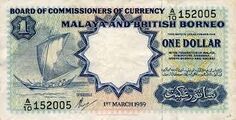
A dollar bill from the British East Indies
Spanish and Portuguese conquistadors (literally Spanish/Portuguese for conqueror) also had deep religious ambitions to convert people to Roman Catholicism. Ferdinand Magellan, a Portuguese conquistador who worked for Spain was sent to look for what other Portuguese travelers called the "Spice Islands", which was Maluku in Indonesia. His slave, who he named "Henrique", a native from Malacca, became his translator and converted him to Catholicism. It is Henrique who accompanied Magellan and allowed him to converse with natives, with played a crucial role in his overseas successes. Instead of finding Indonesia, Megallan discovered the Philippines in 1521 where he and Henrique died in battle against native
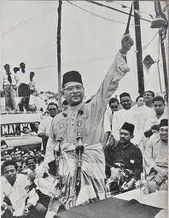
Malaysians celebrate their independence from Britain in 1957
Cebuano armies. Because Islam had such a strong hold in the region, the Portuguese failed to convert the Malays to Catholicism, although they conquered the Sultanate of Malacca. The Malays fought with heavy resistance and eventually bruised the Portuguese into giving it up to the Dutch and the British. Spain took Luzon and Visayas in the Philippines which were Bruneian territory. For some time, the Spanish armies enjoyed successes against the armies of Brunei but had to retreat due to illness. The British and Dutch empires had a much more stable and cooperative rule over Malaysia. The British and Dutch even hired sultans to govern colonial territories in the islands which softened relations between the Malaysians and the colonists. In 1963, Malaysia became an independent monarchy from the United Kingdom. In 1965, Singapore broke away from Malaysia, becoming the last Malay state to gain independence - despite being majority-populated by the Chinese.
Religion[]

Mosque in Putrajaya, Malaysia's religious capital
Malaysia is home to a melting pot of major religions, mostly from Asia. About 60% of Malaysians are adherents to Islam. Most of Malaysia's Muslims are ethnic Malays. According to mainstream Malay culture, it is considered "apostasy" for a Malay to ever convert out of Islam and according to Malaysia's constitution, one has to be a Muslim to
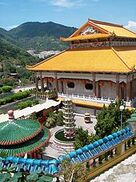
Kek Lok Si, or "Temple of Sukhāvatī", in Penang, Malaysia
be even be considered a Malay. Although Islamic politics is predominant in Malaysia, non-Muslims and non-Malays have played big roles in Malaysian politics and history, particularly Chinese Malaysians and Indian Malaysians. The Malaysian Chinese people are mostly adherents to Buddhism and traditional Chinese folk religion, as well followers of Christianity or atheistic and agnostic. About 19.8% of Malaysians are Buddhists, large Buddhist monastaries can be found in Penang. Penang contains one of Malaysia's biggest Chinese communities, which is where most of the Buddhists are located. Christianity was introduced by the Portuguese and is the second largest monotheistic religion in Malaysia, with most of its followers in Sarawak with communities in Sabah which are practiced by native Bumiputra populations such as the Iban with some Chinese and Indian followers. Most of Malaysia's Christians are
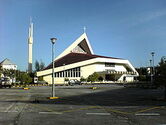
Sacred Heart Cathedral in Kota Kinabalu
Protestants, Roman Catholics, independant churches and Evangelicals. Hinduism is followed by the Indians of Malaysia, who are mostly-Tamil speakers. Like Buddhism, Hinduism is very significant to Malaysia's history and was one of the first major religions to arrive in Malaysia. Despite the presence of Islam in Malaysian politics, freedom of religion is very important in Malaysia. Muslims holy times such as Ramadan and Christian holidays such as Christmas are deemed public holidays in Malaysia. Article 11 of the Malaysian constitution also allows for the propagating of religions, however it is more or less prohibited for Christians and Buddhists to propagate their religion to the Muslims of Malaysia. Most of the overseas Malaysian Americans or Malaysian Australians are Christian or non-religious and tend to be of Chinese or Indian origin rather than Malay.
Language[]
Bahasa Melayu & Bahasa Malaysia[]
The Malaysians speak an Austronesian language known commonly as the Malay language. It is the national language of Malaysia which is considered the main standard version of Malay. It is also known as Bahasa Melayu which literally translates to "Malay language" in Malay itself. In Malaysia, it was changed to Bahasa Malaysia (Malaysian language) to create a sense of unity among Malaysians. To Malaysian Malays, it is referred to as Bahasa Melayu and to the non-Malays of Malaysia, it is referred to as Bahasa Malaysia.
Hokkien and Tamil[]
The Malaysian Chinese people are mostly Hakkas and are native speakers of the Hokkien dialect, rather than Mandarin or Cantonese. The Indians are mostly Tamil-speakers and not Hindi although there are Mandarin and Hindi-speaking minorities in Malaysia.
Other Languages[]
Other natives of Malaysia, the Bumiputra, speak their own respective languages, mostly Austronesian languages as well. These languages include Bajau, Iban, Bugis, Tausūg/Suluk, Dayaks and Javanese which is spoken by Javanese expatriots living in Malaysia. The state of Sabah is home to many Filipino expatriots, and unlike other overseas Filipinos who tend to be Catholics, most of Malaysia's oversease Filipinos are Muslims know as Moros, such as the Tausūgs. These people often speak a Spanish Creole known as Chavacano, many Chavacano-speaking communities can be found in Sabah.
Writing System[]
The Malaysian language (Bahasa Malaysia) is mostly written in the Latin script, however an Arabic script known as Jawi exists for Bahasa Melayu. The Jawi script is mostly used by the Muslim royal families in Malaysia, Brunei, Singapore and the southern Philippines. The Hokkien language is written in the Chinese script and the Tamil language is written in the southern Indian Brahmic script.
Cuisine[]
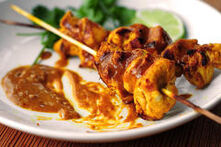
Satay
Malaysia is a haven of cuisines from East Asia from the native and indigenous Malay cuisines, to Chinese, Indian and even Arab dishes. Common meats include chicken and beef; since Malaysia is also home to maritime ethnic groups, seafoods are also predominant in Malaysia. Staple grains include rice. Common spices and ingredients are chillies, curry, coriander, lemon grass, peanut butter and coconut milk. The use of curry was brought over by Indian traders and missionaries. Satay (Malay for saute) is a grilled and marinated food made with skewering meats, seafoods or vegetables. Satay is usually dipped in a sweet, spice and/or sour sauce that is very popular in Malaysia and Southeast Asia. Rice is served with every meal, and is a central part of all Malaysian cuisine, whether it be Malay, Chinese, Indian or indigenous. Any dish that
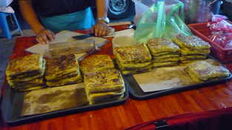
Murtabak
start with the word nesi or nasi mean that the dish is being served with rice, since the word nesi itself literally means rice. A typical rice dish would be nesi lemak. An even more popular rice dish is nesi biryani, which is a spicy rice dish originated from Persia and South Asia, brought over by Indian merchants and missionaries and is part of both Malay and Indian cuisine. Rendang is a spicy beef curry dish from the neighboring Minangkabau people in Sumatra in Indonesia. Murtabak is a folded food that resembles pancakes, brought over by Arab traders. The fillings for murtabak can vary from sweet pastes to meats and entrée foods and is wrapped in banana leaves, a tradition common in all
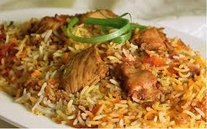
Nesi Biryani
Southeast Asian cuisines. Coconut milk is typically used for sauces, such as satay sauce. Islamic culinary and ethical laws, known as Halal (Arabic: حلال) is very predominant in Malaysian and Malay culinary traditions. The ethnic Malays practice the act of purity which includes not eating anything that is filthy or processed unless it is the only available food for a heavily sick or dying person. Pork and alcohol are always absent from any Malay meal. Many restaurants that are owned by Muslim families recieve Halal certifications. Pork is found mostly in Chinese Malaysian cuisine, although most Chinese restaurants tend to serve halal foods nowadays. The predominantly-Chinese city of Penang attracts many tourists from around the world, known for its fusion of Chinese and Malaysian cuisine. The Chinese cuisine of Malaysia is mainly from the southern parts of mainland China. Bak kut teh (Chinese: 肉骨茶) is pork-rib soup. Bakkwa (Chinese: 肉干) is a barbequed pork kebab that is popular alll over Malaysia and sold by many vendors. Char kway teow (Chinese: 炒粿條) is a rice noodle dish that includes bean sprouts, chicken or duck eggs and Chinese sausages. Pao is a steamed-bun dish that is filled with various sweet meats. Pan mee (Chinese: 板面) is a Hokkien-style egg noodle soup. As for the Indians of Malaysia, chapati is a type of bread from the Punjab region of India. Pandan cake is a popular dessert from Malaysia and other countries in Southeast Asia, which is cake made with pandan leaves and coconut-flavored. The green pigment from the pandan leaves give the cake a greenish-color. Malays and Indians do not use utensils when eating.
Notable Malaysians or People of Malaysian Nationality-Origin[]
|
Parameswara |
A Hindu prince from modern-day Singapore, converted to Islam and found the Sultanate
of Malacca in Malaysia |
|
Hang Tuah |
A famous Malaccan warrior who promised the "forever existance" of the Malays |
|
Enrique of Malacca |
Also known as "Enrique", Magellan's Malaccan slave who helped him translate between Spanish/Portuguese and Malay on his voyages |
|
Mahathir Mohamad |
Malaysia's fourth prime minster, served for 22 years as prime minister of Malaysia and brought the nation up from economic ruin |
|
Azizulhasni Awang |
A Malaysian professional track cyclist, the winner of gold medals in the keirin and 200m sprint events at the Asian Cycling Championships in April 2008. He is among 2012 London Olympics gold medal prospects. In 2009, he became the overall winner of the Keirin event in the 2008–2009 World Cup after obtaining two gold medals and became the first Malaysian to win a medal at the UCI Track Cycling World Championships |
|
Najib Razak |
Current prime minister of Malaysia, belongs to the Bugis ethnic group but considered an ethnic Malay under Malaysia's constitution |
|
Sheikh Muszaphor Shukor |
Malaysian astronaut, first Malaysian, Muslim and Malay into outer space |
|
Yunalis Zarai |
A Malaysian singer and songwriter who has gained much popularity throughout Malaysia |
|
Lat |
A Malaysian cartoonist. Winner of the Fukunka Asian Prize in 2002, Lat has published more than 20 volumes of cartoons since he was 13 years old. His works mostly illustrate Malaysia's social and political scenes, portraying them in a comedic light without bias. |
|
Tunku Abdul-Rahman |
A founding father of Malaysia, who became Malaysia's first prime minister after its independance from Britain |
|
Siti Nurhaliza |
A Malaysian singer, songwriter, record producer and television presenter who won over 200 local awards |
|
Tan Cheng Lock |
A founding father of Malaysia who was a bussinessman and devoted to improve the lives of ethnic Chinese in British Malaya (now Malaysia), and found his organization devoted to this known as the Malaysian Chinese Association. |
|
Alex Yoong |
A Malaysian (Chinese) race car driver from Kuala Lumpur born to a British father and Malaysian Chinese mother, first Malaysian to race with Formula One |
|
Lee Chong Wei |
A Malaysian (Chinese) badminton player who became ranked first for 199 weeks won the silver medal for Team Malaysia during the Olympics |
|
Sambanthan Thevar |
Known commonly as V.T Sambanthan, a Malaysian Indian and founding father of Malaysia, fifth president of the Malaysian Indian Congress, one of the ethnic political groups that contributes to Malaysian society and development |
|
Tony Fernandes |
Entrepreneur from Kuala Lumpur who rescued the airport AirAsia from a failed bussiness into one of the world's most successful, he is a Malaysian Indian |
|
Janaky Athi Nahappan |
A founding member of the Malaysian Indian Congress and the earliest woman to fight for Malaysian independance |
|
Jordan Rodrigues |
An Australian actor, singer and dancer best known for playing Jai Fernandez in the Australian soap opera Home and Away and Christian Reed in Dance Academy, born in Sydney to migrants from Malaysia |
|
James Wan |
An Australian film producer, screenwriter and film director known for directing the famous horror films Saw, Dead Silence, The Conjuring, Death Sentance and Insidious, he is of Malaysian Chinese descent, originally born a Malaysian citizen |
Sources[]
- ↑ http://www.statistics.gov.my/portal/download_Population/files/census2010/Taburan_Penduduk_dan_Ciri-ciri_Asas_Demografi.pdf
- ↑ http://www.censusdata.abs.gov.au/ABSNavigation/prenav/ViewData?action=404&documentproductno=0&documenttype=Details&order=1&tabname=Details&areacode=0&issue=2006&producttype=Census%20Tables&javascript=true&textversion=false&navmapdisplayed=true&breadcrumb=POLTD&&collection=Census&period=2006&productlabel=Country%20of%20Birth%20of%20Person%20(full%20classification%20list)%20by%20Sex&producttype=Census%20Tables&method=Place%20of%20Usual%20Residence&topic=Birthplace&
- ↑ Table 1. First, Second, and Total Responses to the Ancestry Question by Detailed Ancestry Code: 2000". U.S. Census Bureau. Retrieved 4 July 2013.
- ↑ http://en.wikipedia.org/wiki/Malaysians_in_the_United_Kingdom
- ↑ http://www.ancientworlds.net/aw/Article/543335
- ↑ http://www.britannica.com/EBchecked/topic/562024/Srivijaya-empire
- ↑ http://www.britannica.com/EBchecked/topic/358901/Majapahit-empire
- ↑ http://en.wikipedia.org/wiki/Melayu_Kingdom
- ↑ http://www.malaysiahistory.net/v2/?p=135
- ↑ http://longlivezhenghe.blogspot.com/2007/08/zheng-he-and-islam-in-southeast-asia.html
- ↑ http://www.infoplease.com/ipa/A0900121.html
- ↑ http://en.wikipedia.org/wiki/Hang_Tuah


















